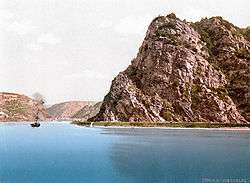Köln-Düsseldorfer
|
Willkommen an Bord! | |
| Aktiengesellschaft | |
| Industry | Transportation |
| Founded | 11 June 1826 |
| Headquarters | Cologne, Germany |
| Products | Cruise ship holidays |
Number of employees | 189 |
| Parent | Viking River Cruises |
| Website | http://www.k-d.com |


Köln-Düsseldorfer (KD) is a river cruise operator based in Cologne, Germany. The company operates a total of 14 cruise ships on the Rhine, Main and Moselle rivers.
The famous KD steamer line operated on the Rhine both with connecting steamers and tourist boats. The Lorelei rock was a famed day outing for pleasure seekers.
History
Early history of tourism in Germany
The first steamboats arrived from England in 1816, heralding a new age of tourism in Germany. Ten years later, the first German shipping line started up its operation between Cologne and Mainz; by 1856 the millionth ticket was proudly sold. In 1832, the first steam boat journeyed from the North Sea all the way to Basel, but this was not a regular service. Mannheim was an established port by 1840, and the river became heavily travelled during the industrial revolution. In 1846 the Ludwig-Donau-Canal was completed after 9 years of work. It was named after King Ludwig I of Bavaria.
The KD Line founded
The KD Steamer Line can trace its history back to 1853 when two earlier companies, the Preussisch-Rheinischen Dampfschiffahrtsgesellschaft (PRDG), the "Köln" company and the Dampfschiffahrtsgesellschaft für den Nieder- und Mittelrhein (DGNM), the "Düsseldorf" company, merged at a time of intense competition and in response to the loss of much of the freight and passenger traffic along the Rhine following the expansion of the railways along its banks.
The KD Line grows
Despite the merger, the two companies, which were established in 1826 and 1836 respectively, maintained semi-independent operations ordering their own vessels which were known as "Köln" or "Düsseldorf" boats. Although other companies operated vessels during this period, especially in the more northerly and southerly stretches of the river, the KD came to dominate and absorb the competitors, such as the Mülheim Company (MDAG), with the exception of the Dutch Steamboat Company (NSM/NSR), which traced its inception back to 1823, when steam was first introduced for passenger and goods transport.
Fleet
Paddle steamers
The KD operated 38 paddle steamers at the outbreak of World War I and 20 at the outbreak of World War II and, although the latter war in particular brought severe losses, it was still felt suitable to raise and rebuild wrecked vessels for further service. The last survivor, Goethe, returned to service in heavily rebuilt form in 1952, and for the 1953 season, there ware 14 large paddlers on the roster. In 1969 this had been reduced to 6 although the shortfall in capacity had been made up by the introduction of similar sized motor vessels. After 1974, with the withdrawal of Cecilie and Bismarck, three paddlers remained, all of which survive.
Preservation
The former KD Rhein paddler Mainz serves as a floating industrial museum on the River Neckar at Mannheim near the Kurpfalzbrücke. Built in 1929, and operational until 1980, she was disposed of from the KD reserve fleet in 1984 and opened in her new use in 1986. Her machinery remains intact.
Goethe remains the only vessel now serving with the KD and is the last example of paddle propulsion.
- PS Goethe [1]
- Built at Cologne in 1913 by Sachsenberg at Cologne-Deutz
- Length : 83 metres - 272 feet (extended from 77.8 m after 1951-2 rebuild)
- Engines : Compound Diagonal, built by Sachsenberg at Rosslau
References
External links
| Wikimedia Commons has media related to Köln-Düsseldorfer. |
- Official website (English)
.png)